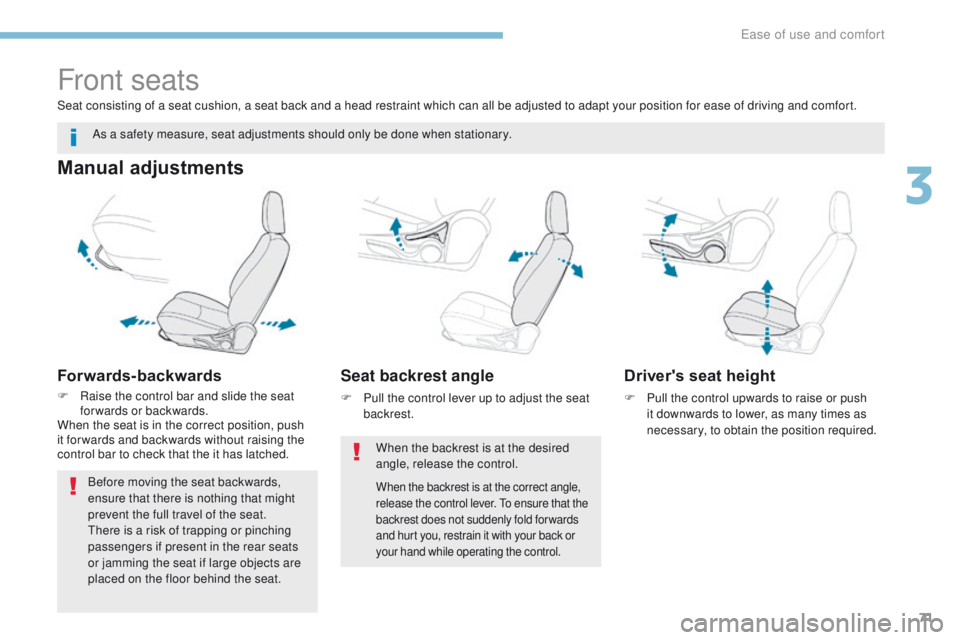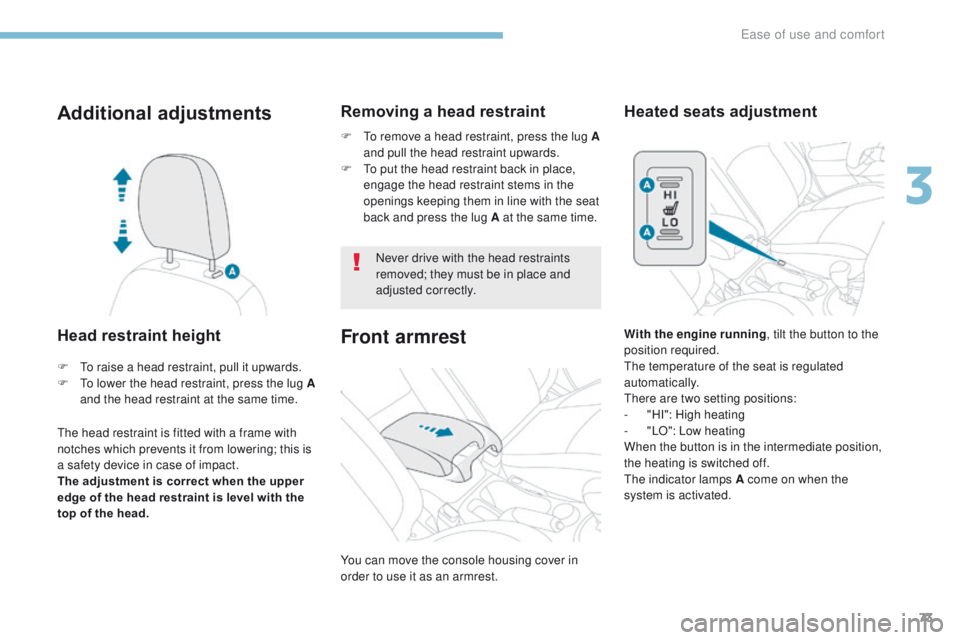Page 4 of 368

.
.
4008_en_Chap00a_sommaire_ed01-2016
Instrument panel 12
Warning and indicator lamps
1
3
Instrument panel screen
1
9
tr
ip computer
3
2
Distance recorder
3
2
tr
ip distance recorder
3
2
Service indicator
3
3
Adjusting vehicle settings
3
7
Audio- CD system screen
4
4
Audio- CD system touch screen
4
6
Audio-
te
lematic system
touch screen
4
8
Lighting dimmer
5
1Remote control key
5
2
"Keyless e
n
try and Starting"
system
5
6
Doors 62
Boot
6
3
Alarm
65
el
ectric windows
6
8
Panoramic sunroof
7
0
Front seats 7 1
Rear seats
7
4
Mirrors
76
Steering wheel adjustment
7
8
Ventilation
7
9
Manual heating / air conditioning
8
1
Automatic air conditioning
8
3
Front demist - defrost
87
R
ear screen demist - defrost
88
Interior fittings
8
9
Boot fittings
9
5Driving recommendations
9
7
Starting - switching off the engine with the key 98
S
tarting - switching off the engine with the Keyless
e
n
try and Starting system
9
9
Parking brake
1
02
Manual gearbox
1
03
ge
ar shift indicator
1
04
CV
t
gearbox
1
05
Hill start assist
1
10
Stop & Start (Auto Stop &
g
o
) system
1
11
Under-inflation detection
1
14
Four wheel drive system
1
18
Cruise control
1
20
Parking sensors
1
23
Reversing camera
1
26
Lighting controls
1
27
Daytime running lamps
1
30
Automatic illumination of headlamps
1
30
Manual guide-me-home lighting
1
31
Welcome lighting
1
32
Headlamp adjustment
1
33
Wiper controls
1
34
Automatic rain sensitive wipers
1
36
Courtesy lamps
1
38
Boot lamp
1
40
Panoramic roof lighting
1
40
Over view
e
co-driving
Instruments Access
ea
se of use and comfort Driving
Lighting and visibility
Contents
Page 5 of 368

.
4008_en_Chap00a_sommaire_ed01-2016
general safety recommendations 141
Direction indicators
1
42
Hazard warning lamps
1
42
Hor n
14
2
Braking assistance systems
1
43
tr
ajectory control systems
1
45
Front seat belts
1
47
Airbags
151
Child seats
1
56
Deactivating the passenger's front airbag
1
58
ISOFIX child seats
1
65
Child lock
1
71
Fuel tank
1
73
Snow chains
1
75
Automatic power cut-off to accessories
176
Changing a wiper blade
1
76
to
wing a trailer
1
77
Fitting roof bars
1
79
Bonnet
180
Petrol engines
1
81
Diesel engines
1
82
Checking levels
1
83
Checks
18
6te mporary puncture
repair kit 1 89
Changing a wheel
1
93
Changing a bulb
1
99
Changing a fuse
2
05
12 V battery
2
11
to
wing the vehicle
2
15
Running out of fuel (Diesel)
2
18
Petrol engines
2
19
Petrol weights
2
20
Diesel engines
2
25
Diesel weights
2
26
Dimensions
231
Identification markings
2
33Bluetooth® telephone with voice
recognition 23 5
to
uch screen A
uD
IO -
t
e
LeM
A
tI
C system
2
47
tOuC
H SCR
e
e
N AuD
IO - CD system
2
89
A
uD
IO - CD system
3
13
Safety
Practical information In the event of a breakdown
te
chnical dataAudio equipment and telematics
Alphabetical index
Contents
Page 7 of 368
5
4008_en_Chap00b_vue-ensemble_ed01-2016
Interior
Boot fittings 95 -96
- r ear parcel shelf
-
s
towing rings
-
storage
Child seats
1
56 -164
ISOFIX mountings
1
65-169
Child lock
1
71
Front seats
7
1-73
Seat belts
1
47-150
gl
ove box
9
0
Deactivating the passenger's air bag
15
2, 15 8
A ir bags
151-155
Front fittings
8
9 -93
-
AuX s
ocket / u
S
B port
-
c
igarette lighter / 12 V socket
-
p
ortable ashtray
-
f
ront armrest
-
s
un visor
-
mat
Rear seats
7
4-75
Rear fittings
9
4
Rear armrest / Ski flap
7
5
.
Over view
Page 13 of 368

11
4008_en_Chap00c_eco-conduite_ed01-2016
Limit the causes of excess consumption
Spread loads throughout the vehicle; place the heaviest items in the
bottom of the boot, as close as possible to the rear seats.
Limit the loads carried in the vehicle and reduce wind resistance
(roof bars, roof rack, bicycle carrier, trailer, etc.). u
s
e a roof box in
preference.
Remove roof bars and roof racks after use.
At the end of winter, remove snow tyres and refit your summer tyres.
Observe the recommendations on
maintenance
Check the tyre pressures regularly, when cold, referring to the label in
the door aperture, on the driver's side.
Carry out this check in particular:
-
b
efore a long journey,
-
a
t each change of season,
-
a
fter a long period out of use.
Do not forget the spare wheel and the tyres on any trailer or caravan.
Have your vehicle serviced regularly (engine oil, oil filter, air filter,
passenger compartment filter, etc.) and observe the schedule of
operations recommended in the manufacturer's service schedule.
When refuelling, do not continue after the third cut-off of the nozzle to
avoid any over flow.
At the wheel of your new vehicle, it is only after the first 1 800 miles
(3
000 kilometres) that you will see the fuel consumption settle down to
a consistent average.
.
eco-driving
Page 65 of 368
63
4008_en_Chap02_ouvertures_ed01-2016
Boot
Opening
F After unlocking the vehicle, press the handle A and raise the tailgate. F
P ull the handle B downwards to guide the
tailgate.
F
R
elease the handle and press gently on the
exterior sur face of the tailgate to close it.
Closing Emergency release
this enables the boot to be unlocked in the
event of a central locking fault.
-
F
old back the rear seats to gain access to
the tailgate release from inside the boot.
-
R
emove the plastic cover from the
opening
A in the tailgate interior pillar.
-
M
ove the control B to the right to unlock
and open the boot.
If the tailgate is not fully closed, this symbol
comes on in the instrument panel screen until
it is closed.
2
Access
Page 73 of 368

71
4008_en_Chap03_Ergonomie-et-confort_ed01-2016
Front seats
Manual adjustments
Forwards-backwards
F Raise the control bar and slide the seat forwards or backwards.
When the seat is in the correct position, push
it for wards and backwards without raising the
control bar to check that the it has latched.
Seat backrest angle
F Pull the control lever up to adjust the seat
backrest.
When the backrest is at the desired
angle, release the control.
As a safety measure, seat adjustments should only be done when stationary.
Driver's seat height
F Pull the control upwards to raise or push
it downwards to lower, as many times as
necessary, to obtain the position required.
Seat consisting of a seat cushion, a seat back and a head restraint which can all be adjusted to adapt your position for ease of driving and comfort.
When the backrest is at the correct angle,
release the control lever.
to e nsure that the
backrest does not suddenly fold for wards
and hurt you, restrain it with your back or
your hand while operating the control.Before moving the seat backwards,
ensure that there is nothing that might
prevent the full travel of the seat.
th
ere is a risk of trapping or pinching
passengers if present in the rear seats
or jamming the seat if large objects are
placed on the floor behind the seat.
3
ease of use and comfort
Page 74 of 368

72
4008_en_Chap03_Ergonomie-et-confort_ed01-2016
Front seats
Electric adjustments
Forwards-backwards
F Push the control for wards or rear wards to slide the seat.
Seat backrest angle
F tilt the control for wards or rear wards to adjust the angle of the seat backrest.
Driver's seat cushion height
and angle
F Pull or push the front part of the control upwards or downwards to raise or lower the
front of the seat cushion.
F
P
ull or push the rear part of the control
upwards or downwards to raise or lower the
rear of the seat cushion.
F
P
ull or push all of the control upwards or
downwards to raise or lower the whole seat
cushion
to a
void discharging the battery, carry
out these adjustments with the engine
running.
Before moving the seat backwards,
ensure that there is nothing that might
prevent the full travel of the seat.
th
ere is a risk of trapping or pinching
passengers if present in the rear seats
or jamming the seat if large objects are
placed on the floor behind the seat.
ease of use and comfort
Page 75 of 368

73
4008_en_Chap03_Ergonomie-et-confort_ed01-2016
Additional adjustments
Head restraint height
the head restraint is fitted with a frame with
notches which prevents it from lowering; this is
a safety device in case of impact.
The adjustment is correct when the upper
edge of the head restraint is level with the
top of the head.Never drive with the head restraints
removed; they must be in place and
adjusted correctly.
F t
o r
aise a head restraint, pull it upwards.
F t
o l
ower the head restraint, press the lug A
and the head restraint at the same time. F t
o r
emove a head restraint, press the lug A
and pull the head restraint upwards.
F t
o p
ut the head restraint back in place,
engage the head restraint stems in the
openings keeping them in line with the seat
back and press the lug A at the same time.
Removing a head restraint
You can move the console housing cover in
order to use it as an armrest.
Front armrestWith the engine running , tilt the button to the
position required.
th
e temperature of the seat is regulated
automatically.
th
ere are two setting positions:
-
"
HI": High heating
-
"
LO": Low heating
When the button is in the intermediate position,
the heating is switched off.
th
e indicator lamps A come on when the
system is activated.
Heated seats adjustment
3
ease of use and comfort